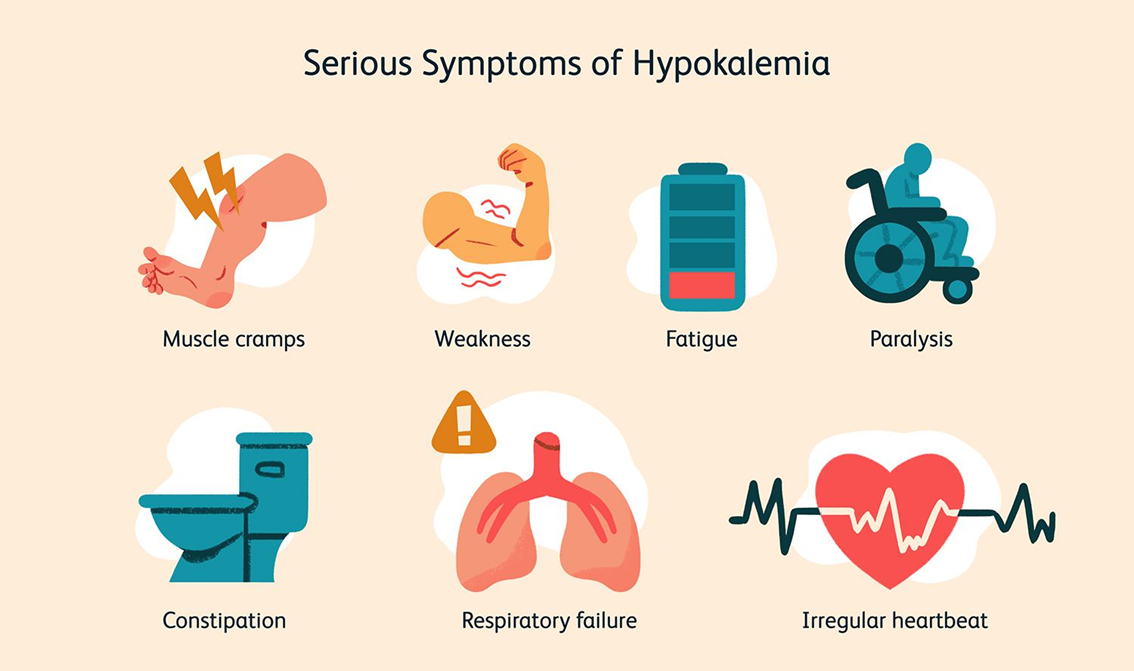A nurse is providing care for a client with hypokalemia. Which condition should the nurse monitor for?
Hypertension
Ketosis
Insulin resistance
Cardiac arrhythmias
The Correct Answer is D
Choice A reason: Hypertension is not directly caused by hypokalemia. While potassium levels can influence blood pressure, hypokalemia is more critically associated with cardiac issues rather than hypertension alone.
Choice B reason: Ketosis is a metabolic state resulting from the body burning fat for fuel instead of carbohydrates. It is not directly related to hypokalemia. Hypokalemia does not cause ketosis, and monitoring for ketosis in a client with hypokalemia is not a priority.
Choice C reason: Insulin resistance is a condition where the body’s cells do not respond properly to insulin. While potassium levels can affect insulin secretion and action, hypokalemia is not primarily associated with insulin resistance. Therefore, it is not the main concern for a nurse monitoring a client with hypokalemia.
Choice D reason: Cardiac arrhythmias are a significant concern in clients with hypokalemia. Potassium is crucial for proper cardiac function, and low levels can lead to abnormal heart rhythms. This is why monitoring for cardiac arrhythmias is essential in clients with hypokalemia.

Nursing Test Bank
Naxlex Comprehensive Predictor Exams
Related Questions
Correct Answer is A
Explanation
The correct answer is a) Serum potassium levels.
Choice A reason:
Serum potassium levels are crucial to monitor in clients with hypervolemia, ketoacidosis, and metabolic acidosis. Potassium imbalances are common in these conditions due to shifts between intracellular and extracellular compartments. In diabetic ketoacidosis (DKA), for example, insulin deficiency and acidosis cause potassium to move out of cells, leading to hyperkalemia. However, once treatment with insulin begins, potassium shifts back into cells, which can cause hypokalemia. Both hyperkalemia and hypokalemia can have serious cardiac implications, making it essential to monitor and manage potassium levels closely.
Choice B reason:
Serum calcium levels are important for overall health, but they are not the primary concern in the context of hypervolemia, ketoacidosis, and metabolic acidosis. While calcium imbalances can occur, they are less common and less immediately life-threatening compared to potassium imbalances. Monitoring calcium is still necessary, but it does not require the same level of immediate intervention.
Choice C reason:
Serum sodium levels are also important to monitor, especially in conditions like hypervolemia where fluid balance is disrupted. However, sodium imbalances are typically managed through fluid management and do not pose the same immediate risk as potassium imbalances in the context of ketoacidosis and metabolic acidosis. Hyponatremia or hypernatremia can cause neurological symptoms, but these are generally less acute compared to the cardiac risks associated with potassium imbalances.
Choice D reason:
Blood urea nitrogen (BUN) levels provide information about kidney function and hydration status. Elevated BUN can indicate dehydration or renal impairment, which are relevant in the context of hypervolemia and ketoacidosis. However, BUN levels do not require the same level of immediate intervention as potassium levels. Monitoring BUN is important for overall management but is not the primary concern in acute settings.
Correct Answer is A
Explanation
The correct answer is a. Insulin is stable at room temperature for one month.
Choice A Reason:
Insulin is stable at room temperature (between 59°F and 86°F) for up to one month. This is important for patients to know, especially if they do not have immediate access to refrigeration. However, it is crucial to avoid exposing insulin to extreme temperatures, such as direct sunlight or freezing conditions, as these can degrade the medication’s effectiveness.
Choice B Reason:
While some types of insulin can be mixed in the same syringe, this practice is not universally applicable to all insulin types. For example, rapid-acting and intermediate-acting insulins can sometimes be mixed, but long-acting insulins should not be mixed with other insulins. Therefore, this statement is not entirely accurate and should be clarified based on the specific types of insulin being used.
Choice C Reason:
Storing insulin in the freezer is not recommended as freezing can damage the insulin, rendering it ineffective. Insulin should be stored in a refrigerator at temperatures between 36°F and 46°F. If insulin is accidentally frozen, it should not be used.
Choice D Reason:
While it is advisable for clients with type 1 diabetes to have backup medication and supplies, storing them in a car is not recommended due to the potential for extreme temperature fluctuations. Insulin and other diabetes supplies should be kept in a stable, controlled environment to ensure their efficacy.
Whether you are a student looking to ace your exams or a practicing nurse seeking to enhance your expertise , our nursing education contents will empower you with the confidence and competence to make a difference in the lives of patients and become a respected leader in the healthcare field.
Visit Naxlex, invest in your future and unlock endless possibilities with our unparalleled nursing education contents today
Report Wrong Answer on the Current Question
Do you disagree with the answer? If yes, what is your expected answer? Explain.
Kindly be descriptive with the issue you are facing.
